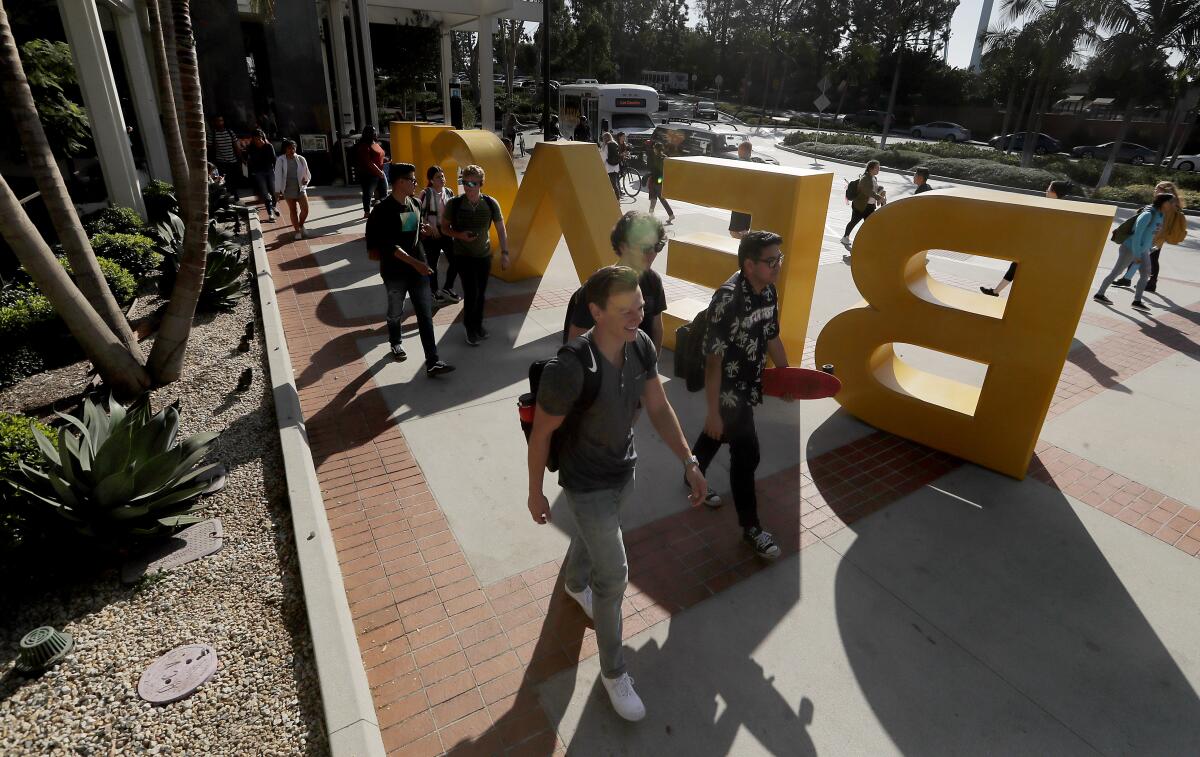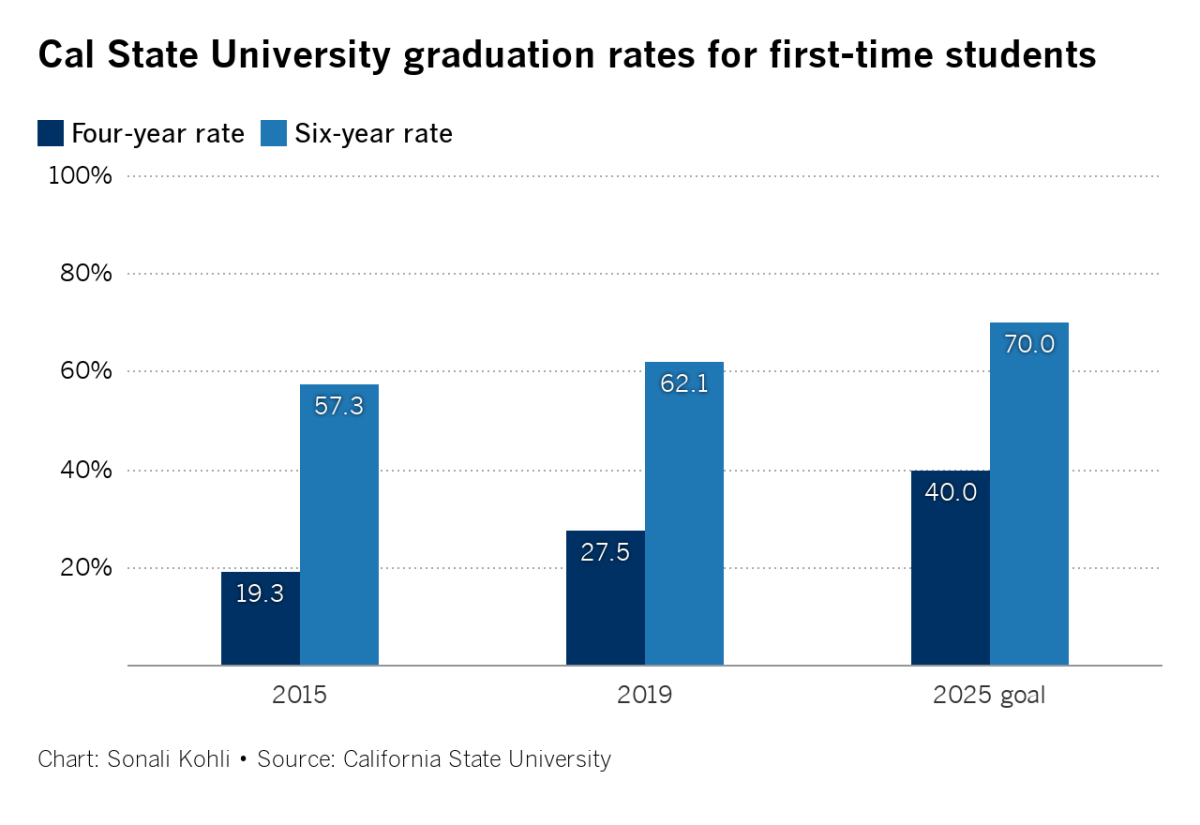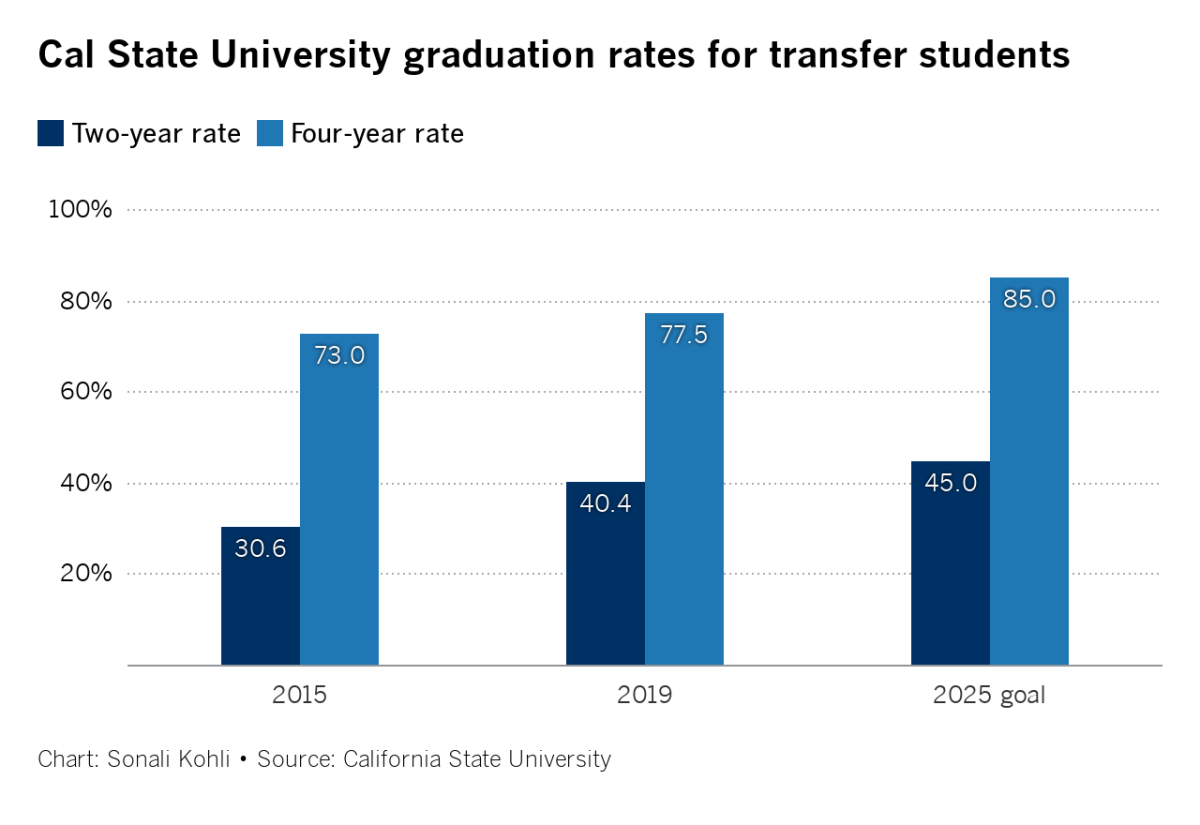As CSU graduation rates climb, Long Beach stands out

- Share via
Graduation rates for the California State University system continued an upward climb, reaching record highs in 2019, although black, Latinx and low-income students continue to graduate at the lowest rates and their gap in achieving a diploma did not narrow this year, according to data released Thursday.
The overall improvements come as the system’s 23 campuses continue to funnel resources through its major graduation initiative, which is expanding course offerings, student advising and financial aid in a major move to raise graduation rates by 2025. To date, the CSU has received $276 million from the state, chancellor’s office and private funders for the initiative.
Twenty-seven percent of students who entered Cal State universities as freshmen four years ago graduated in 2019, up from 19% in 2015, according to CSU’s figures. More than 62% of students who entered as freshmen six years ago graduated, up from 57% in 2015. In total, the university conferred 107,319 baccalaureate degrees in 2019.
“The goals we have set are ambitious, and to see that we’re making steady progress ... is pretty remarkable,” said assistant vice chancellor James Minor. “Given the size and scale of CSU, what happens here has a consequence not only for the state of California but also the rest of the country.”
The CSU, the nation’s largest and most diverse public university system, set goals in 2016 that include raising four-year graduation rates systemwide to 40% and six-year rates to 70%, and eliminating all differences in degree completion among underrepresented minority and low-income students by 2025.
On narrowing those gaps in degree completion, the CSU overall made little progress since last year. “All boats rose ... but the gaps didn’t change,” Chancellor Timothy White said at a Sacramento symposium for Cal State educators Thursday.
Both Minor and White said that the systemwide graduation numbers do not reflect recent changes, such as doing away with remedial math classes. Almost half of all Latinx students and almost 60% of African American students were previously placed in remedial education classes that to do not count toward graduation, Minor said. But under the change enacted in 2018, all of those students now enroll in credit-bearing courses right from the start.
“Those students — their progress to a degree will change pretty dramatically,” Minor said.
Under the initiative, each campus was assigned graduation targets for first-time and transfer students. The system set priority areas for universities to work on, such as adequately preparing students academically, managing enrollment better and removing administrative barriers.


Cal State Long Beach has outpaced the overall system in its progress, increasing the four-year graduation rate for those who enrolled as first-time freshmen to 34% from 16% four years ago. The differences in graduation rates for low-income and historically underserved students as compared to their peers “are at historic lows” of under 3% and under 6%, respectively, Provost Brian Jersky said.
Jersky attributed the progress in part to redesigned “bottleneck courses” that historically had low completion rates, such as physics, math, business and chemistry; better advising; and increased course availability to ensure every student can take the courses they need.
Jersky also pointed to better use of technology to make scheduling easier, identify administrative hurdles to graduation, and help faculty monitor students who need academic support.
“It all takes resources,” Jersky said.
At Sacramento State, the four-year graduation rate hovered around 8% to 9% for decades, said “graduation czar” Jim Dragna. The university has more than doubled its four-year rate to 20%.
It used to be that students were advised to take only 12 credits their first semester to adjust to college studies and increase their chances of academic success, Dragna said. But the university launched a “Finish in Four” campaign encouraging students to take 15 credits in their first semester and 30 total their first year, and offering advising, micro-grants and small incentives to assist them along the way.
“Students then organize their lives in a different way,” Dragna said. “It [also] has an effect psychologically,” motivating them to continue, he said.
Black and Latinx students at Sacramento State are also closing gaps in graduation rates compared with their white peers, with the gap expected to reach zero by 2021, Dragna said.
Progress across the system continues to be uneven, however.
At Cal State Los Angeles, the four-year graduation rate for first-time freshmen has improved only to 11%, compared with 6% four years ago — leaving a stretch to reach its goal of 30% by 2025.
Amy Bippus, the school’s vice provost for planning and budgets, said many students are graduating one semester past four years or in five years, but the report does not reflect those improvements. She said the good news is that the university’s six-year graduation rate is on an upswing, reaching almost 52%, from 45% four years ago.
Like Sacramento State, Cal State L.A. is encouraging all freshmen to take 15 credits their first semester to set them on a four-year graduation path. The strategy is bearing fruit: Two years ago, only 48% of freshmen enrolled in 15 or more units but this fall, 71% did.
At Cal State Dominguez Hills, freshman four-year graduation rates lagged at 11.5%, with a goal of 31%.
William Franklin, vice president for student affairs, said the university is taking many of the same steps as other Cal State campuses, but he also pointed out that the overwhelming majority of Dominguez Hills students are the first in their families to attend college, Pell Grant-eligible and/or black, Latinx or native American.
At Cal State Northridge, freshman four-year graduation rates were slightly higher, at 16.5% up about 3 percentage points from 2015. Provost Mary Beth Walker said Northridge is focusing on improving student retention between the freshman and sophomore years. Data had shown the university lost more than one-third of its students during that transition. The effect of those efforts won’t be seen for at least another year.
More to Read
Sign up for Essential California
The most important California stories and recommendations in your inbox every morning.
You may occasionally receive promotional content from the Los Angeles Times.











